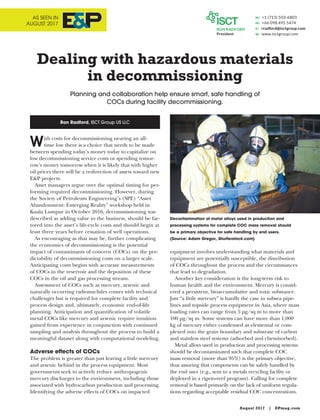
Isct group us llc tech article e&p aug 2017.v f
- 1. August 2017 | EPmag.com Ron Radford, ISCT Group US LLC With costs for decommissioning nearing an all- time low there is a choice that needs to be made between spending today’s money today to capitalize on low decommissioning service costs or spending tomor- row’s money tomorrow when it is likely that with higher oil prices there will be a redirection of assets toward new E&P projects. Asset managers argue over the optimal timing for per- forming required decommissioning. However, during the Society of Petroleum Engineering’s (SPE) “Asset Abandonment: Emerging Reality” workshop held in Kuala Lumpur in October 2016, decommissioning was described as adding value to the business, should be fac- tored into the asset’s life-cycle costs and should begin at least three years before cessation of well operations. As encouraging as that may be, further complicating the economics of decommissioning is the potential impact of contaminants of concern (COCs) on the pre- dictability of decommissioning costs on a larger scale. Anticipating costs begins with accurate measurements of COCs in the reservoir and the deposition of these COCs in the oil and gas processing stream. Assessment of COCs such as mercury, arsenic and naturally occurring radionuclides comes with technical challenges but is required for complete facility and process design and, ultimately, economic end-of-life planning. Anticipation and quantification of volatile metal COCs like mercury and arsenic require intuition gained from experience in conjunction with continued sampling and analysis throughout the process to build a meaningful dataset along with computational modeling. Adverse effects of COCs The problem is greater than just leaving a little mercury and arsenic behind in the process equipment. Most governments seek to actively reduce anthropogenic mercury discharges to the environment, including those associated with hydrocarbon production and processing. Identifying the adverse effects of COCs on impacted equipment involves understanding what materials and equipment are potentially susceptible, the distribution of COCs throughout the process and the circumstances that lead to degradation. Another key consideration is the long-term risk to human health and the environment. Mercury is consid- ered a persistent, bioaccumulative and toxic substance. Just “a little mercury” is hardly the case in subsea pipe- lines and topside process equipment in Asia, where mass loading rates can range from 5 µg/sq m to more than 100 µg/sq m. Some systems can have more than 1,000 kg of mercury either condensed as elemental or com- plexed into the grain boundary and substrate of carbon and stainless steel systems (adsorbed and chemisorbed). Metal alloys used in production and processing systems should be decontaminated such that complete COC mass removal (more than 95%) is the primary objective, thus assuring that components can be safely handled by the end user (e.g., sent to a metals recycling facility or deployed in a rigs-to-reef program). Calling for complete removal is based primarily on the lack of uniform regula- tions regarding acceptable residual COC concentrations. Dealing with hazardous materials in decommissioning Planning and collaboration help ensure smart, safe handling of COCs during facility decommissioning. Decontamination of metal alloys used in production and processing systems for complete COC mass removal should be a primary objective for safe handling by end users. (Source: Adam Gregor, Shutterstock.com) AS SEEN IN AUGUST 2017
- 2. Assessment for key COCs (mercury, arsenic or naturally occurring radioactive material) may not be common prac- tice in all areas. If left contaminated, the equipment may require costly handling by a third-party disposal or decon- tamination contractor, with little residual value of the recy- cled asset recovered. This puts operators, decommission- ing services firms and metals recycling facilities at risk. Complete decontamination The inclusion of assessment and distribution studies into the decommissioning preplanning stage helps ensure complete decontamination of the tubing, flow- lines and topsides processing facilities offshore. The technology required for this has been in development for a decade and has been in full-scale use for two years on the North West Shelf of Australia and in Asia. Depending on data provided from characterization or assumptions from surrogates, some hydrocarbon process systems and equipment might require a phased chemical cleaning approach using multiple chemistries at various temperatures, residence times and flow rates. ISCT designs each chemical decontamination phase to incorporate temperature, residence times and sur- face contact effects for the impacted systems. These design parameters are critical components of a suc- cessful decontamination strategy and are based on the mass, depth profile and distribution of contaminants throughout the systems. Some categories of wastes cannot be exported due to the Basel Convention on the Control of Transboundary Movements of Hazardous Wastes and Their Disposal Treaty. Also, because the costs to dispose of small volumes can be high on a unit weight basis, processing spent chem- ical decontamination fluids and materials is often the only solution for a cost-effective decontamination program. This provides planners a way of estimating costs based on data, production and geographic final disposition. Spent chemistry generated from the decontamination action must be disposed of, processed or reinjected. Disposal without processing (waste minimization) will result in large quantities of hazardous waste or highly reactive material that does not meet discharge crite- ria. Processing COCs must be considered during pre- planning to capture costs and develop comprehensive decommissioning strategies. There are few disposal options for high-concentration waste streams regulated under the Basel Convention, underscoring the importance of materials processing. It makes the most sense to reinject spent production chem- istries downhole in the well or in monitored injection wells where limited processing is required for pH adjust- ment and percentage of total suspended solids. COPYRIGHT © HART ENERGY | 1616 S. VOSS, STE. 1000, HOUSTON, TX 77057 USA | +1 713 260 6400 | FAX +1 713 840 8585
